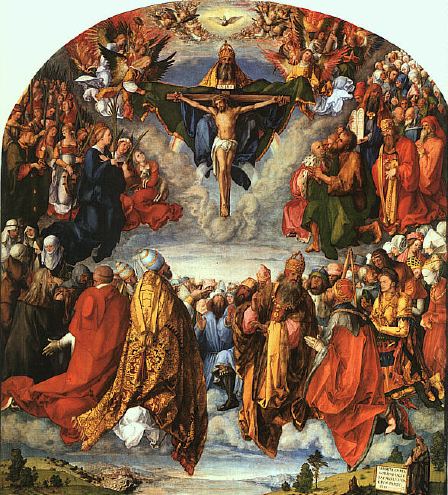Continued from “On the KJV’s impact on the English language, post #1“
Lynne Long, Translating the Bible, from the 7th to the 17th Century
Long’s thesis seems to be that when the King James Version came along, there had been a century of dull literary production in English (C S Lewis’s “drab age”), and that the King James Version was itself part of a major literary revival.
During the 1500s, says Long, “Biblical scholarship improved” in the English language, as versions such as Tyndale’s, the Geneva, and the Rheims New Testament emerged. However, up until the last quarter of the century, “creativity in the English language was not so evident.” “Prose written in what has been termed ‘the drab age’ was ‘clumsy, monotonous, garrulous’, C. S. Lewis tells us; ‘all the authors write like elderly men.” (185) But suddenly, with the onset of the 1580s, a literary revival burst upon the English scene.
“It may have been that the relative stability of Elizabeth’s long reign (her motto was simper eadem, ‘always the same’) produced the security needed for patronage and literary growth. Alternatively the nationalist feeling engendered by the successful defence of the realm from the political attacks of the Pope and the physical attacks of the Spanish could have been the impetus for the wave of innovative English writing that began in the 1580s and 90s. Perhaps the expansion through voyages of discovery and the advances in science and astronomy combined to create the confidence necessary for an upsurge in the quality and quantity of vernacular literature. Whatever the reason, in the last quarter of the sixteenth century ‘with startling suddenness we ascend . . . youth returns’. [Lewis, Literature in Sixteenth-Century England, as with the above CSL quotations too.] The poets Philip Sydney (1554-1606), Edmund Spenser (1552-1599), John Donne (1572-1631); the dramatists Christopher Marlowe (1564-1625) and Ben Jonson (1573-1637); the early novelist John Lyly (1554-1606); translator George Chapman (1559?-1634); sermon writer Launcelot Andrewes (1555-1626); essayist Francis Bacon (1561-1626) and political writer [??I’d say theologian/ecclesiastical writer] Richard Hooker (1553-1600) were all part of a late sixteenth early seventeenth century literary revival that could not [186] help but have an effect, both directly and indirectly, on the subsequent vernacular translation of the Bible.”
A note after the above section: “The essay form was popularized by Francis Bacon, Philip Sydney’s Art of Poesie was the first published attempt at literary criticism, Edmund Spenser’s Faerie Queen was an important development in poetry.”
On drama in that period:
“Drama as a medium became increasingly popular and well-established with the extension of court drama through groups of travelling players and the stettling of companies into permanent buildings like the Globe Theatre which opened in 1599. The Mystery plays continued to be a feature of community life inside and outside London and play going became an accepted form of entertainment.
[NOTE: “The most famous of the Mystery Play cycles in the sixteenth century was perhaps the Coventry Cycle, which included the Shearmen and Taylors’ play about the life of Christ. When Herod discovers that the three Kings have returned home by another way instead of telling him where the infant Jesus was to be found he ‘rages in the pageant and in the street also’ (stage direction line 784, English Mystery Plays edited by Peter Happé, Harmondsworth: Penguin 1985) Shakespeare refers to this famous rage in Hamlet Act 3 scene 2 line 14. Warning the players against over acting, Hamlet says, ‘It out-Herods Herod. Pray you avoid it’.”] Priceless! Continuing:
“The 1590s also saw the rise of literary groups like the Mermaid Tavern circle of which Ben Jonson was a major figure. Most of Shakespeare’s works were written between 1590 and 1611 and Marlowe’s promising career came to an abrupt end in 1593. The major metaphysical poets, Donne and Herbert, were published too late to have the same sort of impact on Scriptural trnalsation as that exercised by the mystics of the fourteenth century on the early English versions, nevertheless Donne was writing in the 1590s with an originality and vigour symptomatic of his generation.” (186)
On Launcelot Andrewes and other preachers: “A more direct effect on the English Bible was . . . preaching” that had impacted “vernacular literature” especially in “the later part of Elizabeth’s reign.” “Akin to drama, preaching remained an important practical means of preventing outlying areas of the country from lapsing into the old ways of religion [assume this means ‘Roman Catholic superstition’]” [NOTE: “The Puritans, although regarded with some suspicion by Elizabeth, were employed to give sermons in the outlying areas simply because they were excellent preachers.” (201)]
CONTINUED:
“[Preaching] was turned into a . . . literary genre by such scholars as Launcelot Andrewes. . . . With others of similar skills he was later to be invited to take part in the making of the King James Bible. Andrewes’ prose bordered on the poetic to the extent that T. S. Eliot could take, three centuries later, a section of the sermon Of the Nativitie: Christmas 1662 and use it for the first five lines of his own poem Journey of the Magi with very little alteration.”
She writes of “the difficulty of assessing the strengths and weaknesses of the King James’ version,” like this: “It is easy enough to point out mistakes or obscurities in the Wycliffite translation or to acknowledge the political bias in Tyndale’s use of ecclesiastical terms, but when the words and phrases of the King James’ version have been a part of the English culture for so long it is impossible to look at them impartially. The whole Church was ‘bound to it and none other’ as the king had wished by virtue of the exclusion of other translations for over two and a half centuries. In some places the wording is a crystallization of the phrasing of previous versions, a final rendering from several earlier drafts, and as such has an even longer pedigree. The well-known passage in Paul’s Epistle to the Corinthians 1:13 is a good example: ‘Though I speak with the tongues of men and angels and have not charity, I am become as sounding brass, or a tinkling cymbal.’ This comes, with the substitution of ‘charity’ for ‘love’, from Tyndale through the Rheims New Testament to the King James Version. A different rendering sounds strange even to the modern ear. The 1976 Good News Bible has: ‘I may be able to speak the languages of men and even of angels, but if I have no love, my speech is no more than a noisy gong or a clanging bell.’ The New International Version, however, keeps the familiar rhythm: ‘If I speak in the tongues of men and [195] of angels, but have not love, I am only a resounding gong or a clanging cymbal.’” (194-5)
“The setting of the English words of the King James Bible to the music of Handel has further embedded them in the culture and increased their familiarity. It is for this reason that C. S. Lewis talks about what he calls ‘the extreme uncertainty of our literary judgement’ in his discussion of Isaiah 30:1. Coverdale has ‘Be of good cheer my people’, the Great Bible ‘Comfort my people’, the Geneva and King James’ ‘Comfort ye, comfort ye my people.’ ‘What chance has Coverdale’s second rendering (in the Great Bible) with us’ he asks, ‘against the familiarity of the Geneva adopted by the Authorised and most unfairly backed by Handel? A man would need to unmake himself before he was an impartial critic on such a point.’ Familiarity makes it impossible to be objective.” (195)
Or on the 23rd Psalm:
“The Geneva rendering sets the rhythm: ‘The Lord is my Shepherd, I shall not want. He maketh me to rest in green pasture and leadeth me beside the still waters.’ The King James’ version retains most of this: ‘The Lord is my Shepherd, I shall not want. He maketh me to lie down in green pasture; he leadeth me beside the still water.’ . . . As these versions are so comfortably familiar, the Good News rendering may not be so immediately attractive . . . ‘The Lord is my Shepherd; I have everything I need. He lets me rest in fields of green grass and leads me to quiet pools of fresh water.’ Al though the modern version has much to recommend it in terms of simplicity and clarity, its unfamiliarity to the ear breaks the pattern of recognition, the common reference point of so much of English Literature.” (195)
Series continued in post #3 here.
Related Articles
- Sneak peek: Christian History magazine reborn with special KJV anniversary issue (gratefultothedead.wordpress.com)
- The KJV and the English Language (zwingliusredivivus.wordpress.com)
- Help us spot phrases from the King James Bible (guardian.co.uk)
- “Prayer closet” a KJV-ism (gratefultothedead.wordpress.com)


 Medieval Wisdom for Modern Christians
Medieval Wisdom for Modern Christians







Pingback: Shakespeares Mystery Play
Pingback: Nobody Greater by Vashawn Mitchell (MP3) February 28, 2011 « Faith Center